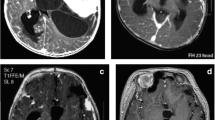Abstract
Case reports. Four cases of desmoplastic infantile ganglioglioma (DIG) seen in India are described. These patients presented with large, supratentorial, superficially situated cystic tumours that showed glial and ganglionic differentiation; accompanied by a severe desmoplastic reaction. MIB-1 labelling was rare, despite foci of apparently primitive neuroepithelial cells. There was lacking p53 protein expression by tumour cells in all cases. The prognosis was good following either partial or complete tumour resection. DIGs are a distinct form of developmental neuroepithelial tumour, probably arising from neural progenitor cells in subcortical zone along with mature subpial astrocytes.
Conclusions. In view of its favourable prognosis, this tumour has to be diagnosed accurately by immunohistochemical techniques using glial and neuronal markers. The absence of p53 protein expression suggests that DIG probably has different molecular genetic pathways from other supratentorial astrocytomas.
Similar content being viewed by others
Author information
Authors and Affiliations
Additional information
Electronic Publication
Rights and permissions
About this article
Cite this article
Rout, P., Santosh, V., Mahadevan, A. et al. Desmoplastic infantile ganglioglioma – clinicopathological and immunohistochemical study of four cases. Childs Nerv Syst 18, 463–467 (2002). https://doi.org/10.1007/s00381-002-0610-3
Received:
Issue Date:
DOI: https://doi.org/10.1007/s00381-002-0610-3




